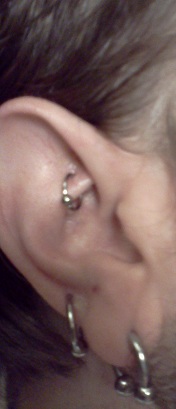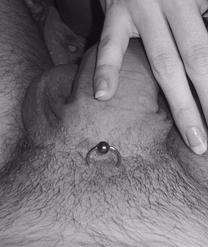
The Prince Albert (PA) is a penis piercing which extends from the urethra to the underside of the glans. It is one of the most common male genital piercings. The related reverse Prince Albert piercing enters through the urethra and exits through a hole pierced in the top of the glans.

A lip piercing is a type of body piercing that penetrates the lips or the area surrounding the lips, which can be pierced in a variety of ways.

A bridge piercing is a facial piercing through the skin on the bridge of the nose, usually directly between the eyes of the wearer. A variation on this piercing, the vertical bridge piercing is a surface piercing, with all of the risks or potential complications related to surface piercings.

A navel piercing is a type of piercing that penetrates the skin of the navel. It is most commonly located on the upper fold of skin but can also be affected underneath or around the edges of the navel. Healing usually takes around 6–12 months but varies person-to-person due to differences in physiology.

A clitoral hood piercing is a female genital piercing through the clitoral hood surrounding the clitoris. In addition to being an adornment, a clitoral hood piercing can enhance sexual pleasure during masturbation, foreplay and intercourse. In an empirical study at the University of South Alabama, the authors reported a positive relationship between vertical clitoral hood piercings and desire, frequency of intercourse, and sexual arousal. There are two main types of clitoral hood piercing: the vertical clitoral hood (VCH) piercing and the horizontal clitoral hood (HCH) piercing. As the names indicate, the difference is in the direction the piercing is oriented in the skin above the clitoris. Neither of these piercings penetrates the clitoris itself, although in common parlance they are sometimes called "clit" piercings. The deep hood piercing is a variation of the clitoral hood piercing that passes deeper through the clitoral hood.

Nose piercing is the piercing of the skin or cartilage which forms any part of the nose, normally for the purpose of wearing jewelry, called a nose-jewel. Among the different varieties of nose piercings, the nostril piercing is the most common.

Earrings are jewelry that can be worn on one's ears. Earrings are commonly worn via a piercing in the earlobe or another external part of the ear, or by some other means, such as stickers or clip-ons. Earrings have been worn across multiple civilizations and historic periods, often carrying a cultural significance.

An eyebrow piercing is a vertical surface piercing, wherein a twelve to eighteen gauge cannula needle is inserted through the bottom of the eyebrow and exits through the top of the eyebrow to permit insertion of jewelry. Those performing the piercing may use a pennington clamp to better guide the needle through the skin. A curved barbell is the most common jewelry inserted post-piercing.

A tongue piercing is a body piercing usually done directly through the center of the tongue. Since its decline in popularity around 2011, it has seen a recent upsurge making it now the second most popular piercing amongst young women aged 18–25 in 2019. It has become quite unpopular amongst men, although in the 1990s and early 2000s, it was more popular for men than women to get and associated with punk culture. Midline tongue piercings, or one hole through the center of the tongue is the most common way to have the tongue pierced.

A hafada piercing is a surface piercing anywhere on the skin of the scrotum. Piercings on the scrotal raphe or "seam" of the scrotum are common. This piercing does not penetrate deep into the scrotum, and due to the looseness and flexibility of the skin in that area, does not migrate or reject as much as many other surface piercings. The main motives are beautification and individualization. A piercing that passes through the scrotum, from front-to-back, or from side-to-side, is known as a transscrotal piercing. Multiple hafada piercings are not uncommon, often as an extension of a frenum ladder or Jacob's Ladder, which is a series of piercings from the frenulum to the scrotum.

A transscrotal piercing is a body piercing that travels through the scrotum from front to back, or from side to side. It is a high risk procedure.
Body piercing jewelry is jewelry manufactured specifically for use in body piercing. The jewelry involved in the art of body piercing comes in a wide variety of shapes and sizes in order to best fit the pierced site. Jewelry may be worn for fashion, cultural tradition, religious beliefs, personal symbolism, and many other reasons.

James Mark Ward is an American body piercer. In a 2004 documentary, entitled The Social History of Piercing, MTV called him "the granddaddy of the modern body piercing movement."

A guiche piercing is a body piercing through the perineum. Guiche piercings are much more common in men than in women. Although a guiche normally runs perpendicular to the direction of the penis, lateral placements are possible. A series of guiche piercings in parallel to the direction of the penis is called a guiche ladder, and might commonly be seen as an extension of a frenum ladder.

A rook piercing is a perforation of the antihelix of the ear for the purpose of wearing jewelry. It is located just above the tragus on the ridge between the inner and outer conch with the piercing passing from the underside to the top of this ridge, differing from many ear piercings that essentially span between a "front" and "back" surface. Erik Dakota, a well known professional piercer and the individual responsible for originating and popularizing the rook piercing, is said to have named this modification after a shortened version of his first name. The piercing was first named in issue #4 of the magazine Body Play and Modern Primitives Quarterly around 1992 alongside the first printed reference to the industrial piercing, then termed "industrial ear project".

A pubic piercing is a body piercing in the pubic area. The term usually refers to a piercing at the base of the penis, making it a male analogue to the Christina. Healing times are typically around 3–4 months. As this is essentially a surface piercing, the rejection rate is higher than most "conventional" piercings. Some get this piercing because it can offer direct stimulation to the clitoris during intercourse. Standard placement is horizontal, at the natural juncture where the bottom of the pubic mound meets the base of the penile shaft. Curved barbells are the most common initial jewellery, although a ring may be an option and many wearers replace their starting jewellery with rings once the piercing has healed. Piercings further up the pubis may also be possible, but this would not be a 'pubic piercing' as such but rather a surface piercing on the pubis. For these placements a staple-shaped surface bar would likely be used to give the best chance of healing.

A Madison piercing is a body piercing going through the skin at the front of the neck. They are surface piercings, and have a high rate of migration and rejection. They have a long healing period, if they heal at all. The Madison piercing is named after the first person publicly associated with it, the porn star Madison Stone.

In body modification, an implant is a device that is placed under the human skin for decorative purposes. Such implants may be subdermal or transdermal. In the context of body modification, some may consider injections of silicone and other substances a type of implant as well.

A plug, in the context of body modification, is a short, cylindrical piece of jewelry commonly worn in larger-gauge body piercings. Modern western plugs are also called flesh tunnels. Because of their size—which is often substantially thicker than a standard metal earring—plugs can be made out of almost any material. Acrylic glass, metal, wood, bone, stone, horn, glass, silicone or porcelain are all potential plug materials.

Horst Streckenbach "Tattoo Samy" was a well-known German tattoo artist and historian of the medium, who had been tattooing since 1946. Streckenbach is considered important in the development of tattooing in Germany. With Manfred Kohrs from Hanover in Germany from 1974 to 1978 he developed a rotary tattoo machine and in 1975 the barbell.






















